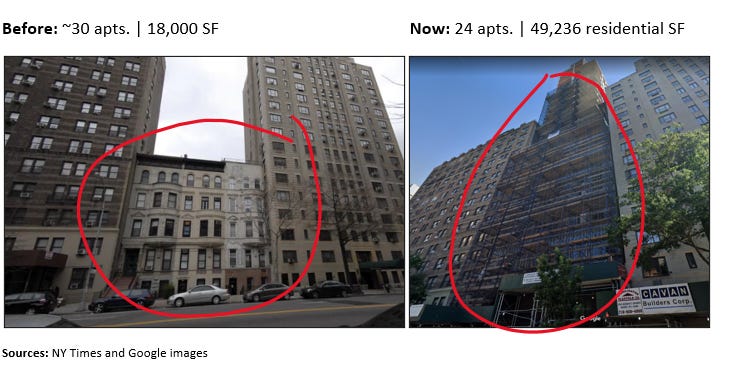This week
Low density development in Manhattan
Lumber prices decline
NYS commits to going electric
Facts about NYC’s housing stock you didn’t know
New York faces a nuanced housing issue. Justin Fox, a former editor for Harvard Business Review and current contributor at Bloomberg, highlights key things around the housing problem:
The number of apartments in NYC that sit vacant has increased by 42% from 2017 to 2021. Vacancies grew at an average rate of 10% a year to > 350,000 vacant apartments in 2021.
From 1965 to 2021, the number of apartments occupied by renters (i.e., not homes or condos) hardly changed, going from 2.1M to 2.2M. In the same period, owner-occupied units have doubled from 0.75M to 1.5M.
In some Manhattan neighborhoods, incentives and zoning rules encourage redevelopments that reduce total supply of apartments. From 2010 to 2020, developers on the upper east side (see 8th City Council district) demolished almost as many apartments as they created. Demolitions are only viable when the new housing built is significantly larger than the original property’s square footage, due to the expensive costs of development. To add to the housing stock only marginally, despite going through the efforts of building properties from the ground up, implies low-density property development that allocates more square footage for each unit and less units per building. Like chopping a pizza 4 ways instead of into 8 slices.
Source: Bloomberg News
Source: Bloomberg News
New developments are contributing to housing scarcity
In higher income areas like the Upper West Side of Manhattan, developers are demolishing multifamily properties and replacing them with low-density properties. New properties with less apartments are replacing old properties with comparatively more units, and this is introducing scarcity to the housing market.
According to developers, the economics do not justify any other approach. Land costs are too high, zoning is not lenient enough, and now, with the expiration of the 421A abatement, tax incentives do not line up.
But is that beside the point? If private developers own land, do they need to provide excuses for why they are not using it the way 3rd parties wish it was? Some developers like Miki Naftali have taken this stance. Naftali says he is simply responding to market signals and is oriented to maximizing returns for investors, like most U.S. companies.
Something to keep in mind: developments that demolish 20 multifamily rental units and replace them with 16 condos are reducing total apartments in NY by a count of 4. But they are reducing the rental housing supply by a count of 20. Transferring units from the supply of rental apartments to the pool of owner-occupied condos contributes to the rising rents in NYC.
Policy makers are taking note. Gale Brewer, former Manhattan Borough President who had a key role in approving large developments, has voiced her dissent on developments that lower NY’s supply of apartments. The clock may be ticking till regulation sets in…
15 West 96th Street, New York, NY
→ National News
Lumber prices drop to lowest level in 2 years
Lumber futures traded at $429 on Tuesday, up only 15% from 2019 averages, pre-pandemic.
This is significant because wood prices surged during the pandemic and two by four prices tripled, according to WSJ.
The drop in prices is likely tied to slowing demand for new housing: monthly residential construction is 13% lower than it was in April.
The double whammy of higher wood supplies and hiked interest rates is putting pressure on pricing. Wood suppliers may need to cut back their sales to maintain profitability.
The National Association of Home Builders reports that builder confidence is at similar levels to where it stood around the 2008 housing crash.
NY prepares for the advent of electric vehicles (EVs)
NY Governor Kathy Hochul confirmed on Thursday that NY state will transition to 100% EV sales by 2035 (due to a legal technicality, California had to go first).
The Federal Highway Administration also approved NY’s plan to install 60,000 EV charging stations every 50 miles along NY state highways.
Commercial real estate owners of property near highways (rest stops, housing, hotels) will be tapped by the NYS Dept. of Transportation to submit proposals to have EV charging stations built on their properties.
NY’s EV Make-Ready program will fund up to 100% of the construction of EV stations.
NYC’s own push into EV infrastructure growth, fleet development, and financing for these initiatives is under way – the plan can be read here.
In NYC, motor vehicles and commercial real estate are the leading sources of carbon emissions. It will be interesting to see the tools the city uses to incentivize building owners to participate in the electrification of the city.
Best Regards,
Romain Sinclair
646 326 2220
Sources: Wall Street Journal, New York Times, NYC Government, Bloomberg news, Commercial Observer




